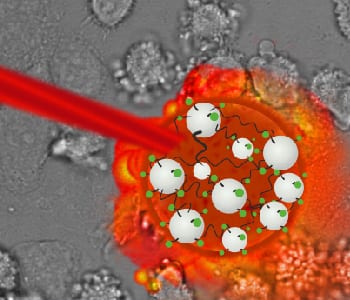On the quest to develop novel methodologies to treat diseases, the utilization of light as a trigger has fascinated many researchers and clinicians. In particular, near-infrared (NIR) light has the key advantage of being minimally absorbed by skin and tissues. Within the NIR window, which comprises wave-lengths of about 650 to 900 nm, light can penetrate tissue in the order of hundreds of micrometers to centimeters.
The treatments of cancer by photothermal therapy (PTT) and photodynamic therapy (PDT) are among the most promising ones under development. PDT is based on photothermal transducers that can use light to produce reactive oxygen species which induce tissue destruction. On the other hand, PTT makes use of specific photothermal transducers that can effectively transform NIR light into local heat, surpassing the traditional hyperthermia methods such as hot-water bath, radiation, or heated blood perfusion.
 Marcelo Calderón and co-workers at the Institute of Chemistry and Biochemistry of the Freie Universität Berlin, Germany, reported the design of a responsive nanogel system for a combined photothermal and photodynamic therapy of cancer. Based on a radical precipitation method, the near infrared absorbing cyanine green dye IR806 was conjugated to the macro crosslinker polyglycerol and polymerized into a thermoresponsive polyether based nanogel network.
Marcelo Calderón and co-workers at the Institute of Chemistry and Biochemistry of the Freie Universität Berlin, Germany, reported the design of a responsive nanogel system for a combined photothermal and photodynamic therapy of cancer. Based on a radical precipitation method, the near infrared absorbing cyanine green dye IR806 was conjugated to the macro crosslinker polyglycerol and polymerized into a thermoresponsive polyether based nanogel network.
The nanogels were internalized in carcinoma cells and showed a preferential accumulation in mitochondrial compartments as reported for cyanine green dyes. Upon NIR irradiation, the nanogels produced hyperthermia and reactive oxygen species that could efficiently ablate carcinoma cells by a combination of PDT and PTT. Because of the high chemical functionality of the nanogel structure and the versatility of the synthetic methodology, it would be possible to test other dyes, drugs, and targeting modalities, which could increase the specificity and efficacy of the multifunctional nanogels.

















